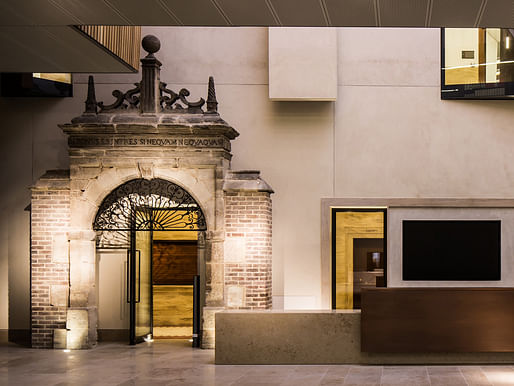

Beginning as the New Bodleian Library, the Weston Library at Oxford University was designed by Sir Giles Gilbert Scott and constructed in the 1930s. Although construction finished in 1940, wartime purposes delayed the building's official opening in 1946. For the most part, the building remained unaltered other than the addition of the Indian Institute as a south-facing roof extension in 1966-69 by architect Robert Potter and other minor changes in 2010. Then in 2011, London-based Wilkinson Eyre Architects began renovating the Grade II building, which reopened to the public this past weekend.

The £80 million redesign is part of the Bodleian's efforts to better preserve -- and promote -- their vast special collection of books, manuscripts, and other historical objects. In their redesign, Wilkinson Eyre vied to revamp the building's infrastructure while respecting its heritage. As if the collections weren't already enough to gaze in awe at, Wilkinson Eyre also added new reading rooms, research and media facilities, exhibition galleries, a lecture theater and seminar rooms, and connectivity to neighboring structures -- in hopes to open up the library to the broader community, in addition to researchers and students.
Read on for further details about the refurbishment:

"Once described as a ‘dinner jacket made of Harris Tweed’, the Weston Library is now successfully connected to the core Bodleian buildings. The new Blackwell Hall, supported by a £5m donation from Julian Blackwell, is a publicly accessible, top-lit 13.5 meter high space which forms the heart of the new library and features a café, information desk, a 16th Century tapestry map (the Sheldon Tapestry) and a 15th Century gateway on permanent loan from the V&A Museum.
The gateway [shown in the cover photo] originally led to the garden of the historic Dorner family’s estate at Ascott Park in Oxfordshire and was the only surviving structure following a fire in 1662. With the support of Oxfordshire Buildings Trust, the incorporation of this gateway sees this grand piece of architecture returned to its original home in a new setting."

"Blackwell Hall opens up to two new exhibition spaces and a café, being directly accessible through the new public entrance on Broad Street. Exhibition galleries have been added, along with a Digital Media Centre, a Visiting Scholars Centre, a lecture theater, and a suite of seminar rooms for teaching and master-classes based on the library’s special collections.
These facilitate contemporary research practices and techniques, supporting the library’s academic users, as well as public interaction with the library’s collections. The refurbished library includes world-class conservation workshops and facilities, where collections can be preserved in a secure and environmentally stable setting. The Bodleian’s Special Collections experts will now all be co-located in the building with their Conservation colleagues, as will the Centre for the Study of the Book."

"Scott’s original design replicated the typology of an Oxford University college but with the traditional quadrangle space in the center occupied by an 11-story book stack based around a large complex of unprotected steel framework. [Wilkinson Eyre] revised the layout, removing the upper floors of this colossal central stack, and replacing them with a dedicated reading room and suite equipped with the latest research facilities. The three-story stacks underground have been partially rebuilt and upgraded to modern archival standards, and for the first time, controlled shafts of daylight permeate into the heart of the building."
No Comments
Block this user
Are you sure you want to block this user and hide all related comments throughout the site?
Archinect
This is your first comment on Archinect. Your comment will be visible once approved.